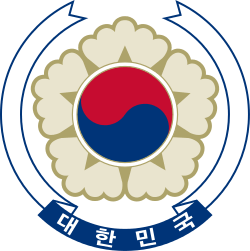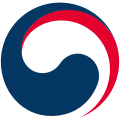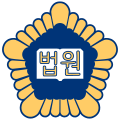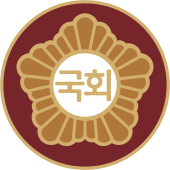South Korean legislative election, 1992
| | |||||||||||||||||||||||||||||||||||||||||||||||||||||||||||||||
| |||||||||||||||||||||||||||||||||||||||||||||||||||||||||||||||
| |||||||||||||||||||||||||||||||||||||||||||||||||||||||||||||||
 |
| This article is part of a series on the politics and government of South Korea |
| Constitution |

|
|
Judiciary 
|
Parliamentary elections were held in South Korea on 25 March 1992.[1] The result was a victory for the Democratic Liberal Party, which won 149 of the 299 seats in the National Assembly. However, DLP's seats shorten from 218 to 149 seats, less than half of whole seats, so this regarded as retreat. Voter turnout was 71.9%.
Parties
The ruling Democratic Liberal Party was formed in 1990 through the merger of the former ruling Democratic Justice Party along with two opposition parties, the Reunification Democratic Party (RDP) and the New Democratic Republican Party (NDRP). DLP gain 218 seats, which is bigger than 2/3 of whole seats. The party supported President Roh Tae-woo and included among its members former opposition leader Kim Young-sam and former Prime Minister of South Korea Kim Jong-pil.
The leading opposition party was the Democratic Party. It was formed in 1991 through the merger of the Party for Peace and Democracy led by Kim Dae Jung and former members of the NDRP with the minor Democratic Party. The party was co-led by Kim and Lee Kitack. DP got 97 seats, which was almost reach 100 seats (one third of the whole seats) for "protect constitution".
The United People's Party was a conservative, centrist, Economic nationalism, pro-business party led by businessmen Chung Ju Yung of hyundai. The party campaigned heavily on the issue of the economy and the poor record of President Roh's government. Despite of new party, UPP won 31 seats, which is more than 10% of the seats with 17.4% of vote. It joined the opposition.
These major three parties competed in presidential elections on 19 December, which ended with DLP candidate, Kim Young-sam's victory.
Results
| Party | Votes | % | Seats | +/– |
|---|---|---|---|---|
| Democratic Liberal Party | 7,923,719 | 38.5 | 149 | |
| Democratic Party | 6,004,577 | 29.2 | 97 | |
| United People's Party | 3,574,419 | 17.4 | 31 | New |
| New Political Reform Party | 369,044 | 1.8 | 1 | New |
| People's Party | 319,041 | 1.5 | 0 | New |
| Fairness People's Party | 21,007 | 0.1 | 0 | New |
| Independents | 2,372,005 | 11.5 | 21 | +12 |
| Invalid/blank votes | 259,670 | – | – | – |
| Total | 20,843,482 | 100 | 299 | 0 |
| Source: Nohlen et al. | ||||
References
- ↑ Dieter Nohlen, Florian Grotz & Christof Hartmann (2001) Elections in Asia: A data handbook, Volume II, p420 ISBN 0-19-924959-8
External links
- 1992 election in South Korea Inter-Parliamentary Union

.png)

